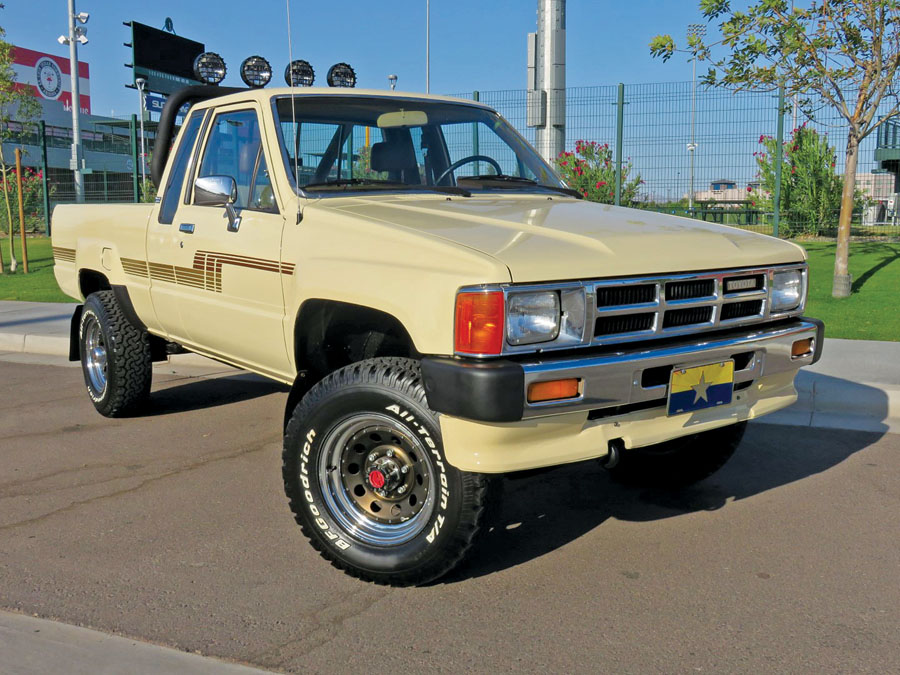
The imported mini-truck surged in popularity in the wake of the first 1970s fuel crisis and rising gas prices. The 4-cylinder engines in the import trucks were more economical than the V8 and straight-6 engines that powered the bigger domestic models.
The little trucks from Toyota, Datsun/Nissan, and Mazda offered more responsive handling than their larger cousins. The Big Three got into the import truck market as well. Ford sold a Mazda pickup as the Courier, while Chrysler sourced its Ram 50 and Plymouth Arrow trucks from Mitsubishi. The Chevrolet LUV pickup was actually manufactured at Isuzu.
For the most part, the mini-trucks used the same design as any full-size truck. They used a body-on-frame chassis with a solid rear axle suspended beneath semi-elliptical leaf springs.
Front suspension layouts varied, but starting in 1986 Toyota introduced the High Trac Independent Front Suspension, which featured dual A-arms with a torsion bar mounted to the upper A-arm on each side. This advanced design offered a major improvement in drivability over solid front-axle designs for 4x4 trucks.
Mini-truck interiors were typically spartan, and engines were generally underpowered by modern standards. The 1986 Toyota featured a 2.4-liter engine rated at 114 horsepower and 140 pound-feet of torque. The 4-speed automatic transmission sapped off most of that power, and the 4WD system ate up the rest.
Upgrade options were not much better. The turbocharged Toyota 22R-TE engine that became available in the mid-’80s produced only 135 horsepower and 173 ft-lb of torque.
However, the fundamental virtues of these trucks were timeless: They were cheap, useful and fun to drive.
By 1985, the American market for small trucks was over 1 million units per year. For many young men of the era, these trucks were the first vehicles they purchased new and the first vehicles they ever loved. Adventures were taken, sweethearts were courted, and at least a few children were conceived in the beds of these trucks. Now, those young men are in their 50s, and an excellent example of their first good ride might make a fine addition to a collection.
A rare survivor
Our subject 1986 Toyota SR5 pickup sold for $20,900, including buyer’s premium, at Mecum’s recent Denver auction. The truck features 4WD, automatic transmission and factory air conditioning.
That feature set, along with the beige paint and brown sticker package, was a popular choice in the era. As Toyota’s top-of-the-line truck, the original retail sticker price would have been right around $10,858.
Toyota trucks cost a bit more than the competition. For comparison, a base 2WD Mazda B2000 was available new for $5,995 in the same year, and a comparable Nissan Deluxe King Cab 4x4 was $9,695.
The truck in question appears to be original and in excellent shape — to the point one would wonder if it was ever used at all. The side-graphic decals are present and have not curled. The paint on the bed appears unscratched. The interior is similarly virginal, and even the engine is unusually clean.
The truck’s light bar was a popular aftermarket addition in the day. According to the auction catalog, only the stereo has been changed — CD players were an expensive option in the mid-1980s, and the original cassette deck and radio would long since have perished. But the photos also show a set of aftermarket wheels, although they’re not any more attractive than the stock wheels.
One interesting note is that the truck still doesn’t have a rear bumper. Mini-trucks in this era were generally sold without the bumper. Basic or heavy-duty stamped steel rear bumpers were available as a dealer-installed option, but many buyers elected to go with aftermarket tube bumpers instead of the OEM units.
Used and abused is usual
The auction sale price, including buyer’s premium, was $20,900, which means the bid price was around $19,000. That’s pretty good appreciation for a 30-year-old truck with more or less standard equipment, especially when the NADA value guide says this truck should be worth a maximum of $2,825.
There have been only a handful of comparable auction sales over the past five years, with some examples running as high as $30,500 (SCM# 226774).
Don’t expect a fleet of small pickups to start popping up at auctions. Most small trucks from this era were used up and badly abused over the years, and a clean example will be extremely rare. Plus, nostalgia will motivate only so many buyers.
However amusing having a copy of your first truck might be, and however rare a top example of a mid-’80s pickup might be, there will never be much of an upside to restoring any less-than-excellent example.
Vehicles from this era are complex enough to be hard to restore and cheap enough that they will not inspire many people to try. So the fundamental rules of collecting still apply: Buy the best example you can find and enjoy it for what it is. ♦
